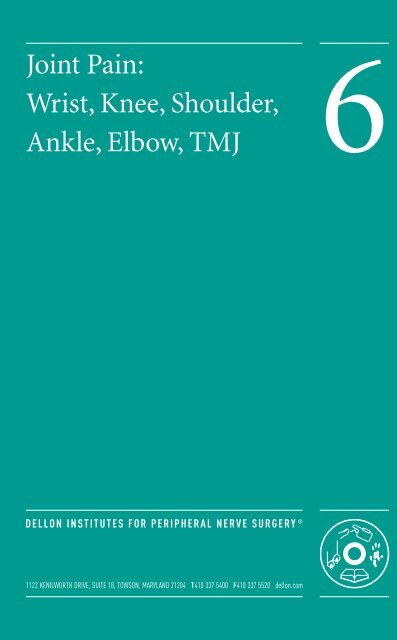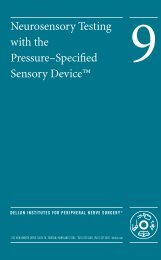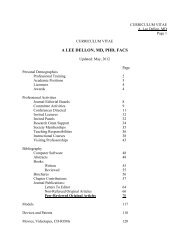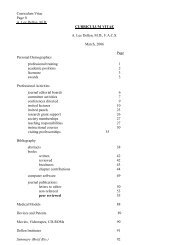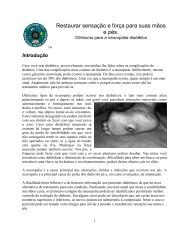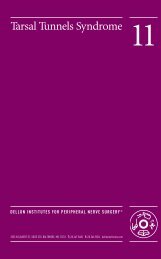Joint Pain: Wrist, Knee, Shoulder, Ankle, Elbow, TMJ
Joint Pain: Wrist, Knee, Shoulder, Ankle, Elbow, TMJ
Joint Pain: Wrist, Knee, Shoulder, Ankle, Elbow, TMJ
- No tags were found...
You also want an ePaper? Increase the reach of your titles
YUMPU automatically turns print PDFs into web optimized ePapers that Google loves.
y o u r c o m p l a i n t s a r eYour wrist hurts when you bend it up or down.Your knee hurts when you walk, climb steps or kneel.The outside of your ankle hurts when you walk.The front of your shoulder hurts when you lift your arm.Your elbow hurts on the outside, Tennis <strong>Elbow</strong>, or theinside, Golfer’s <strong>Elbow</strong>, with certain movements.The side of your jaw hurts when you bite down.w h at c au s e s y o u r c o m p l a i n t s ?Small nerves that are in the painful joint havebeen injured.These nerves do not go to the skin or to muscles.These small nerves only send a message of pain.These nerves were torn or stretched when you either:directly injured that joint in an accident, ordeveloped arthritis from natural causes, orhad an operation in or around that joint.t r e at m e n t w i t h o u t s u r g e r yBe sure to see a medical or surgical specialist interested inSports Medicine, Orthopedic Surgery, or Podiatric Footand <strong>Ankle</strong> Surgery. They will examine the ligaments to besure they are not damaged, and obtain special x-rays, likea mri, to evaluate the ligaments and joint structures.If it is your jaw that hurts, see a Dentist or anOral Surgeon.Structural integrity (strength) of all joint structuresmust be present before a joint denervation procedurecan be done.Your doctor will prescribe anti-inflammatory medicationor you may have had a “cortisone shot” into the joint.You doctor may suggest physical therapy to strengthenthe muscles and ligaments around the joint, and/or a brace.If it is your jaw, you will try “bite blocks” or realignyour teeth.You may have already had surgery on your joint, such asarthroscopic surgery, or even had a joint replaced.w h e n s h o u l d i h av e s u r g e r y ?When your joint pain symptoms are unrelieved bythe above approaches, and you wish to be more activewithout pain.A nerve block will be given to be sure which nerve(s)cause(s) your pain. If this relieves your pain, thenpartial joint denervation can be up to 90% successful.TOLL FREE 877-DELLON-1JOINT PAINDELLON INSTITUTES FOR PERIPHERAL NERVE SURGERY ®DELLON.COM
w h at i s t h e s u r g e r y l i k e ?The surgery takes about one and one-half hours.The surgery is performed as an outpatient.l o c at i o n s o f n e rv e s t o j o i n t sNerves to the inside ofthe knee joint and thesurrounding skin.The surgery is performed with general anesthesia.An incision is made over the location where the nervesending the pain signal is located.Each nerve is removed without entering the joint.The end of the nerve is put into a new place, like amuscle, so it cannot grow back to the joint and causepain again.Local anesthesia is placed into the skin and around thenerve so there is little pain after the surgery.You can use your shoulder, arm, wrist and hand, oryour leg, knee, ankle, and foot, or your jaw (eating andtalking), immediately after surgery.Nerves to the outsideof the knee joint andthe surrounding skin.There is no loss of motor function with this surgery,and you will still know what position your joint is in.Usually, no therapy is necessary, but gradual strengtheningis encouraged as your body needs to learn to usethat joint normally again. Water walking or watertherapy is often the best way.LEFTNerves to the front ofthe shoulder.RIGHTNerves to the outsideof the ankle joint.TOLL FREE 877-DELLON-1JOINT PAINDELLON INSTITUTES FOR PERIPHERAL NERVE SURGERY ®DELLON.COM
CALL TOLL FREE877-DELLON-1to find the locationof the nearestDellon Institutew h at a r e t h e r i s k s o f s u r g e r y ?The published outcomes of the Dellon-approach to thetreatment of joint pain of neural origin offer the bestchance for success for relief of your symptoms. Thereare risks associated with every surgical procedure, suchas the risk of anesthesia, bleeding and infection.Complications unique to joint denervation procedures are:Unpredictable nature of the healing process(scar formation).If nerves to the skin were entrapped in scar from previousoperations, and need to be removed in addition tothe joint denervation, then there will be areas of skinremaining numb.Need for a second surgery to remove an additionalnerve will be necessary in 5 to 10% of people.Underlying arthritis will continue.If a joint has been replaced, there is the rare risk ofeither exposing the joint implant or an infectionoccuring around the implant.w h o s h o u l d d o t h i s s u r g e r y ?Surgeons from the Dellon Institutes for PeripheralNerve Surgery® have the most advanced trainingand experience doing this surgery, which offers youthe best chance for success.b e i n g a c a d e m i c i n p r i vat e p r a c t i c e smDellon AL, Mackinnon SE, Daneshvar A: Terminal branch of anteriorinterosseous nerve as source of wrist pain. J Hand Surg 9B:316-322, 1984.Dellon AL: Partial dorsal wrist denervation: Resection of distal posteriorinterosseous nerve. J Hand Surg 10A:527-533, 1985.Horner G, Dellon AL: Innervation of the human knee joint and implicationsfor surgery. Clin Orthop Rel Res 301:221-226, 1994.Dellon AL, Mont MA, Hungerford DS: Partial denervation for treatmentof persistent neuroma pain after total knee arthroplasty. Clin Orthop RelRes 316:145-150, 1995.Aszmann OC, Dellon AL, Birely B, McFarland E: Innervation of thehuman shoulder joint and its implications for surgery. Clin Orthop RelRes 330:202-207, 1996.Dellon AL, Mont M, Mullik T, Hungerford D: Partial denervation forpersistent neuroma pain around the knee. Clin Orthop Rel Res 329:216-222, 1996.Rab M, Ebmer J, Dellon AL: Innervation of the Sinus Tarsi: Implicationsfor treating anterolateral ankle pain.Annals Plastic Surg, 47: 500-504, 2001.Dellon AL: Denervation of the sinus tarsi for chronic post-traumaticlateral ankle pain.Orthopedics, 25: 849-851, 2002.Davidson JA, Metzinger SE, Tufaro AP, Dellon AL: Innervation of thetemporomandibular joint. J Craniofacial Surg, 14: 235-239, 2003.Dellon AL, Barrett S: Sinus Tarsi Denervation: Clinical Results. J AmerPod Med Assoc, 95:108-113, 2005.Dellon, AL: Partial <strong>Joint</strong> Denervation I: <strong>Wrist</strong>, <strong>Shoulder</strong>, <strong>Elbow</strong>, PlastReconstr Surg, 123: 197-207, 2009.Dellon, AL: Partial <strong>Joint</strong> Denervation II: <strong>Knee</strong>, <strong>Ankle</strong>, Plastic ReconstrSurg, 123:208-217, 2009.BROCHURESIN THIS SERIES:Carpal TunnelSyndromeCubital TunnelSyndromeFoot DropGroin <strong>Pain</strong>Heel <strong>Pain</strong><strong>Joint</strong> <strong>Pain</strong>Nerve Injury andRepairNeuropathyNeurosensoryTesting WithThe Pressure-SpecifiedSensory DeviceRadial NerveEntrapmentsTarsal TunnelsSyndromeThoracic OutletSyndromeTOLL FREE 877-DELLON-1JOINT PAINDELLON INSTITUTES FOR PERIPHERAL NERVE SURGERY ®DELLON.COM


